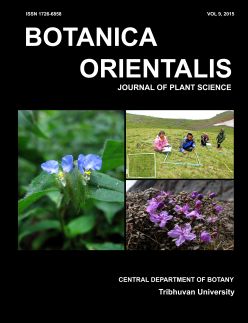Comparative study of encapsulated and non-encapsulated protocorms for the propagation of Cymbidium aloifolium (L.) Sw. on two different media
DOI:
https://doi.org/10.3126/botor.v9i0.21014Keywords:
Protocorms, in vitro, germination, encapsulation, mediaAbstract
Artificial seed technology is a powerful tool for the propagation of rare and threatened species with high economic value. In the present investigation, medium-sized protocorms of Cymbidium aloifolium were encapsulated with 3% sodium alginate and 0.2 M calcium chloride dihydrate (CaCl2.2H2O) solution. In vitro culture of encapsulated protocorm was carried out on different strength (1.0, ½ and ¼) of two different liquid media, viz. Murashige and Skoog (MS) and Knudson (Kn C), and full strength (1.0) of both media supplemented with 0.5 mg/l 6-benzyl aminopurine (BAP) and 0.5 mg/l á-naphthalene acetic acid (NAA). In vitro germination and seedling development from encapsulated protocorm was compared with non-encapsulated protocorm inoculated on similar culture conditions. Six replicates were used for each treatment. The full strength of MS medium without plant growth regulators was found to be the most favourable condition for germination and plantlet regeneration of C. aloifolium. However, earlier seedling development was achieved from encapsulated (after 18.5 ± 0.84 weeks of culture) than non-encapsulated (after 20.5 ± 0.34 weeks of culture) protocorm. In addition, 100% of encapsulated protocorms were viable when stored for 20 days at 4°C, while non-encapsulated protocorms showed only 6.67% viability on 10 days storage at 4°C and later they lost their viability. For acclimatization, plantlets regenerated from encapsulated protocorms were successfully hardened in a potting mixture of cocopeat and clay (3:1) with 85% survival rate. The present investigation has provided a standard protocol for short- to mid-term storage and efficient conversion of plantlets of C. aloifolium through artificial seed technology, which could be beneficial for commercial production of this orchid and its germplasm preservation.
Botanica Orientalis – Journal of Plant Science (2015) 9: 40–48
Downloads
Downloads
Published
How to Cite
Issue
Section
License
This license enables reusers to copy and distribute the material in any medium or format in unadapted form only, for noncommercial purposes only, and only so long as attribution is given to the creator.




